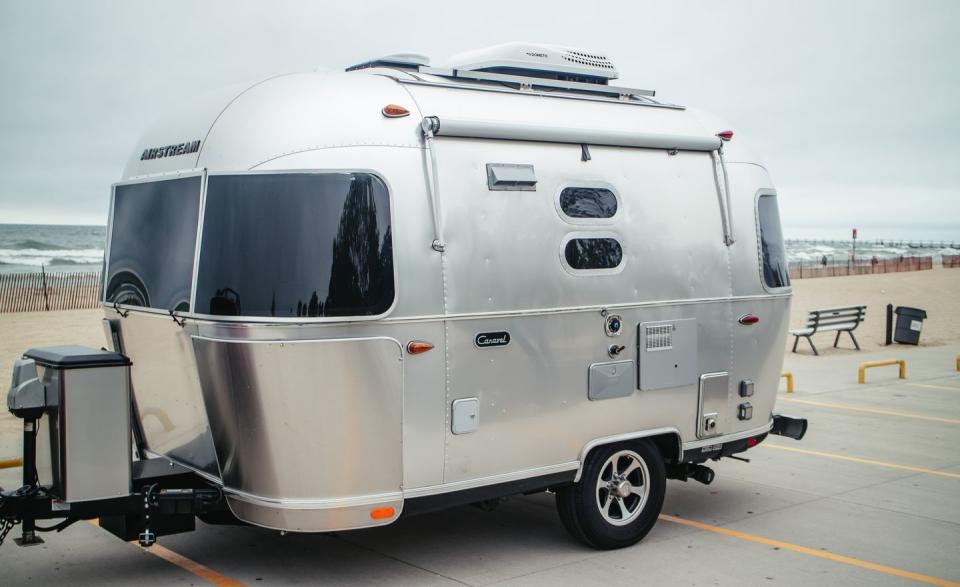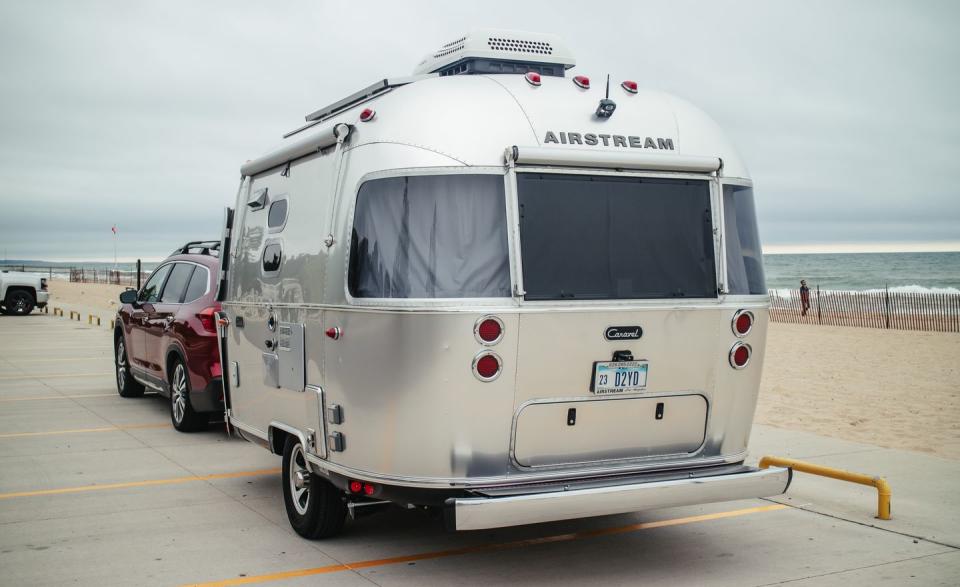2020 Airstream Caravel Is a Miniature Hotel Room on Wheels

Airstream, purveyor of luxury camping trailers that are nicer than most Car and Driver editors' homes, has reintroduced its Caravel line of lightweight and comparably affordable trailers. Unlike the company's fiberglass-bodied Nest trailer, the Caravel is instantly recognizable as an Airstream, as it shares the iconic shiny aluminum construction, rounded roof, and wraparound front window of the brand's larger models. Intended to appeal to (well-heeled) first-time camper-trailer buyers, the compact Caravel lineup consists of 16-, 19-, 20-, and 22-foot long models, each with a unique floorplan with room for four campers.
Since the single-axle Caravel—our example was the shortest, 16-foot-long model—can be towed by an average mid-size SUV rather than requiring a half- or three-quarter-ton pickup truck, we planned a long weekend getaway using our long-term Subaru Ascent as a towing vehicle. We may be novice campers, but armed with the Caravel's owner's manual and a few tips from the local Airstream dealership, we set off for Michigan's Grand Haven State Park on the sandy shores of Lake Michigan, an easy three-hour drive west from our headquarters in Ann Arbor.

Loaded up and Truckin'
The Caravel proved surprisingly easy to tow behind the big Subaru. Cruising at 75 mph is the trailer's happiest speed, tracking straight and feeling hunkered down with minimal swaying within its lane. Keeping that speed steady, though, required constant working of the Ascent's turbocharged 2.4-liter flat-four, which buzzes noisily at 3000 rpm. Tugging the Caravel, the Ascent's continuously variable automatic transmission (CVT) frequently avoided running near its most efficient top ratio, which helped to drop our fuel economy to about 9 mpg. After our trip, we briefly hooked up the Caravel to our long-term Volkswagen Atlas to see if the VW's naturally aspirated V-6 and eight-speed automatic might make easier work of moving the Airstream, but we managed the same 9 mpg, and the trailer didn't feel as stable as it did behind the Subaru.
The Caravel's short overall length makes it easy to maneuver in reverse, which was a boon once we reached our campsite. In just a few minutes (and only two attempts), we were backed into our site and ready to detach from the Subaru. Leveling the trailer on a less-than-tabletop-flat surface with its four manually retractable stabilizing jacks proved to be a more challenging task. The built-in level at the tongue of the Caravel showed that no matter what we did, we were always pretty far off. It wasn't until we retracted the jacks on one side so that the left tire was touching the ground that we finally got it right.

Hooking up to the site's 30-amp electrical service was as easy as connecting one side of the provided power cord to the camper's electrical panel and the other end to the power source. The Caravel's onboard inverter automatically delivers power to the various outlets, USB ports, and appliances. Our test camper came equipped with the optional 90-watt solar package ($1700), which juices the Caravel's onboard battery with enough electrons to keep the fridge cold for at least a few hours while off the grid.
Getting Away from It All
Staying in the as-tested $65,284 Caravel hardly can be considered "roughing it." Airstream has packed all the essentials plus luxuries such as air conditioning, a gas furnace, an electric heat pump, onboard Wi-Fi, an integrated Bluetooth stereo, a mini fridge, a gas stove top, and a microwave into its smallest camper. Even the smallest model feels far roomier inside than its dinky exterior measurements suggest. With the curtains fully drawn, the trailer feels open and airy and still quite cozy at night with the shades closed. The bedroom features a flat-screen TV with an HDMI hookup, so we were able to spend a few hours catching up on our latest Netflix obsessions. A roof-top antenna and a built-in Blu-ray player provide alternative entertainment options.

Faux wood laminated half-walls visually separate the bedroom from the rest of the Caravel's interior, and a patterned curtain can be pulled to provide privacy. The richly colored veneer contrasts sharply with the kitchen's white-and-black motif and the trailer's shiny aluminum walls. The driftwood-colored vinyl flooring mimics wood planks and was easy to keep clean with a simple broom. Carpet would have been a chore at our beachfront locale. The black vinyl cushions for the dinette are the sole letdown in an otherwise contemporary and convincingly high-end interior. The fabric feels cheap, and the backs of the cushions aren't secured to the wall, so they move around unless you remain perfectly still.
The main bed—located in the rear and snuggled up next to a second wraparound window in our test model—is about the size of a full mattress. For two people, it's an intimate sleeping situation best suited for couples who don't mind the close proximity. The Caravel's dinette can be converted to accommodate an extra two guests by dropping the table part down and using the unsecured back rests to complete the bed.

Almost All of the Conveniences of Home
Overhead storage above the Caravel's kitchenette and dining area is plentiful for a weekend of camping and would likely offer enough storage for even a week or two away, but standard cereal boxes are too tall to fit, creating an issue for our breakfast plans. Luckily, there's a floor-to-ceiling closet with a door between the bedroom and the kitchen. Our other kitchen-related gripe concerns the lack of counter space. Utilizing the dinette's table is a good substitute, but foodies may find the longer 20-foot model and its L-shaped kitchen counter to be more convenient.
We lucked out with temperate weather during our stay in Grand Haven, so we had no need to use the built-in air-conditioning unit or either of the Caravel's heaters. In the name of testing, we did kick the A/C on and close up the windows to see how quickly the cabin would cool off, which didn't take long, and, unlike some rivals, the Caravel is fitted with ducted vents strategically placed throughout the interior to help diffuse the cool air. All Caravel models come equipped with a ceiling-mounted exhaust fan with a rain sensor that shuts it down and closes the cover automatically—a feature we were happy to have when a line of showers passed through our campground overnight.

At the end of the weekend we were bummed to pack up and head back to the real world, as Airstream's shiny little camper had delivered a welcome respite from workweek stress. The sound of crashing waves, the absence of an alarm clock, and the lack of a rigid itinerary surely contributed to our relaxation, but that could be had with any beachfront hotel room. It's clear that the Caravel—itself a sort of rolling hotel room—adds an element of freedom that a brick-and-mortar resort simply cannot. And for the Airstream's price, we'd expect nothing less. It might require a few tasks upon arrival at a campsite to get it ready for use, but in our experience, the Caravel was worth the effort.
You Might Also Like

